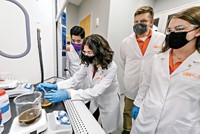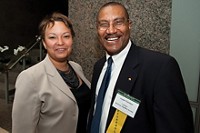Advertisement
Grab your lab coat. Let's get started
Welcome!
Welcome!
Create an account below to get 6 C&EN articles per month, receive newsletters and more - all free.
It seems this is your first time logging in online. Please enter the following information to continue.
As an ACS member you automatically get access to this site. All we need is few more details to create your reading experience.
Not you? Sign in with a different account.
Not you? Sign in with a different account.
ERROR 1
ERROR 1
ERROR 2
ERROR 2
ERROR 2
ERROR 2
ERROR 2
Password and Confirm password must match.
If you have an ACS member number, please enter it here so we can link this account to your membership. (optional)
ERROR 2
ACS values your privacy. By submitting your information, you are gaining access to C&EN and subscribing to our weekly newsletter. We use the information you provide to make your reading experience better, and we will never sell your data to third party members.
Green Chemistry
2019 Green Chemistry Challenge Awards announced
Winners are greening technology from laundry to pharmaceuticals
by Sam Lemonick
June 10, 2019

There is no single answer to the question of how to make chemistry greener. People and companies working on a variety of solutions are winners of the 2019 Green Chemistry Challenge Awards. Tonight, at a ceremony in Washington, DC, the US Environmental Protection Agency (EPA) honored groups that developed rechargeable batteries using abundant materials, a biobased process to make a chemical found in a variety of products, a more efficient manufacturing process for an antibiotic, and a more environmentally friendly laundry process.
The event was held on the eve of the combined Green Chemistry and Engineering Conference and International Conference on Green and Sustainable Chemistry, meeting this week in Reston, Virginia
Rechargeable batteries power everything from phones to electric cars, but the metals used to make them, including lithium, nickel, and cadmium, can be expensive and are less abundant than some other elements. Sanjoy Banerjee of the City College of New York was recognized for his efforts developing rechargeable batteries that use more abundant zinc and manganese. Also recognized were the CUNY Energy Institute of which he’s director, Sandia National Laboratories, Brookhaven National Laboratory, and Urban Energy Power, a company Banerjee founded to market these batteries. Zinc and manganese dioxide are already used in typical AA alkaline batteries. But they cannot be recharged because structures that form during discharge would short out the batteries. Banerjee and collaborators modified zinc-manganese dioxide batteries with additives that prevent this problem. He and his cohonorees have commercialized the technology for use in grid stabilization, renewable energy storage, and household use.
Another group was honored for work on biobased chemicals. Chemists at start-up Kalion and the Massachusetts Institute of Technology (MIT) developed a fermentation process by which modified Escherichia coli bacteria make glucaric acid. Glucaric acid is a six-carbon sugar with carboxylic acid groups at each end. Kalion markets the sugar for use as a corrosion inhibitor, a chelating agent, an additive in polymers, a counterion for drugs, and a precursor to an energy drink ingredient. Chemicals commonly used in these applications are today generally derived from petroleum products. Kalion’s chief scientist and MIT chemist Kristala Prather and colleagues designed the method for making
Washing Systems is also working on alternative chemicals, in their case for commercial laundry processes. The company says its technology eliminates the need for ecosystem-disrupting phosphates and bases like sodium hydroxide, which are used in the large laundry systems commonly found in large facilities such as hotels and hospitals. Their systems are designed to use biodegradable surfactants instead. The company says the method also uses less water and electricity than conventional processes.
Finally, Merck Research Laboratories received an award for changing the way it makes ceftolozane, an antibiotic sold in combination with another chemical as the drug Zerbaxa. By changing to a crystallization-based purification process, the company says it increased product yield by 50% and reduced raw material costs by 50%. The company also says it reduced the process’s carbon footprint and energy and water use.
The Green Chemistry Challenge Awards recognize people and entities developing technology that embrace the principles of green chemistry, which include limiting waste, using renewable feedstocks, and designing for less hazardous chemicals or processes. They were called the Presidential Green Chemistry Challenge Awards until 2017. The EPA selects the winners from a pool nominated by a panel of experts convened by the ACS Green Chemistry Institute. ACS publishes C&EN.





Join the conversation
Contact the reporter
Submit a Letter to the Editor for publication
Engage with us on Twitter